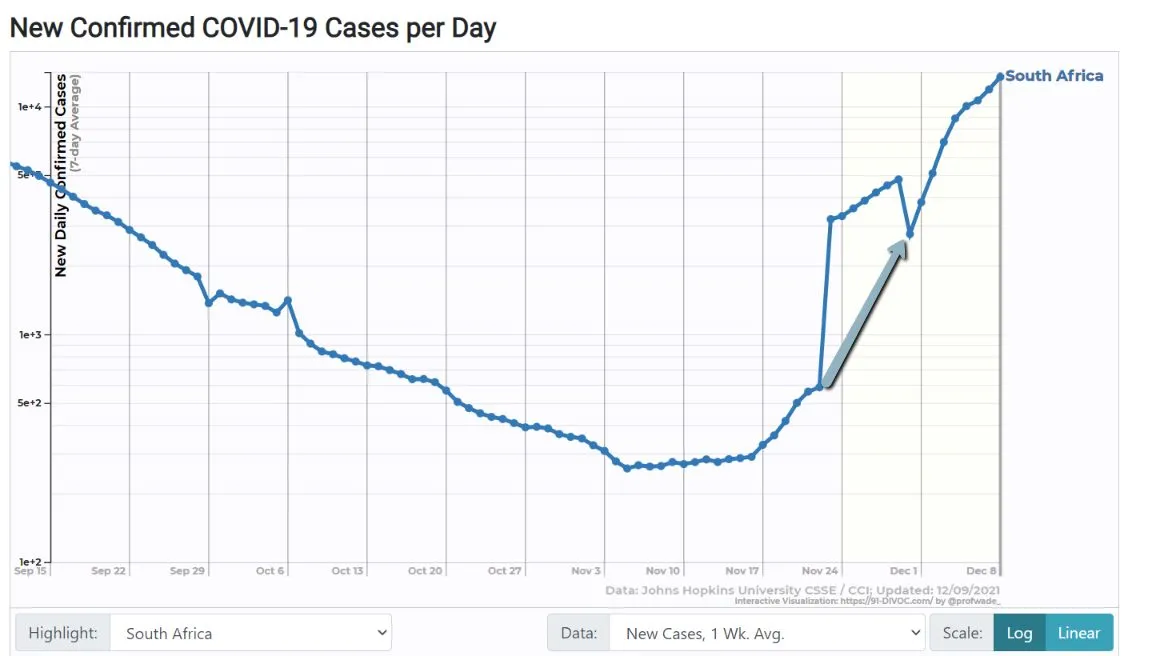
South Africa continues to post rapidly growing case rates, and it's now almost all Omicron. Still no solid read on how severity compares to Delta. (Most of the data so far are terribly ambiguous, see below.) Ignore the one-week bump from a backlog of data, the underlying curve is fairly smooth. Note that this is a log chart, straight lines are actually exponential curves.
In the US, the northern states are spiking at a rate similar to last year's pre-Alpha holiday wave. (Recall we had the holiday wave before vaccine availability, then a modest bump on the downside as Alpha hit and vaccines were deployed, then the Delta wave in the summer.)
Remember that this is still all Delta. Omicron is at such a tiny fraction in the US (under 1/10 of one percent) that it is not impacting overall numbers. That will change once Omicron reaches about 20% or so.
I expect Omicron to be dominant by the end of January, plus or minus a few weeks. It's hard to be sure because we don't know if it's currently 0.1% or 0.01% or whatever. By the time it reaches 2-3%, we should have a much better read on the timing.
It is clear that Omicron attacks double-vaxxed or previously infected people far better than previous variants...roughly as well as the Wuhan strain infected previously unexposed people. It isn't clear how well it will do against boosted or 2vax+infection people. It also isn't clear whether it's more or less contagious than Delta for uninfected, unvaccinated people.
South Africa is seeing signs that could suggest it's less deadly than Delta, but pretty much all of these signs are ambiguous. Some examples:
- If a lower percentage of cases are being admitted to hospitals, is that because it's milder, or because the cases include a much larger share of vaccinated or previously infected people who have a head start on fighting it off? The curves would look the same.
- If hospital stays are shorter, is that because it's milder, or because most of the admissions were previously vaccinated or infected people?
- If the symptoms are milder, is that because Omicron is milder, or because the population infected in November is much younger and healthier than the population of previous waves?
Until we get hospitalization and fatality rates split by age, previous infection and vax status, we just won't know.
LOOKING FORWARD
My guess is we'll see the Delta holiday wave peak around year end, start to decline, and then a big jump back up as Omicron takes over at roughly triple the rate of Delta. This could cause a massive spike in infections among non-boosted or previously infected people. (It looks like 3x vax or 2x vax plus infection should provide decent protection against infection.)
I'm hoping that the previously vaxxed or infected crowd won't have high levels of severe disease, so the health care system will be dealing almost exclusively with the unvaxxed, uninfected population. If that's not the case - if significant numbers of vaxxed or previously infected people are hospitalized - the steep Omicron wave is going to be ugly.
If you or people you know are vaxxed but not boosted, PLEASE get boosted ASAP. Vaxxed antibodies against Omicron are literally 1/40th as effective as they were on Delta, but the booster multiplies it 25x - a huge boost.
My guess is the February will be the key month for health care impact. If Omicron is fairly mild in vaxxed or previously infected people, the huge wave of cases may not be that bad. But if the hospitalization rates are anything like the Delta waves, we're in for a rough time. Fingers crossed, we should know a lot more in a week or so.
